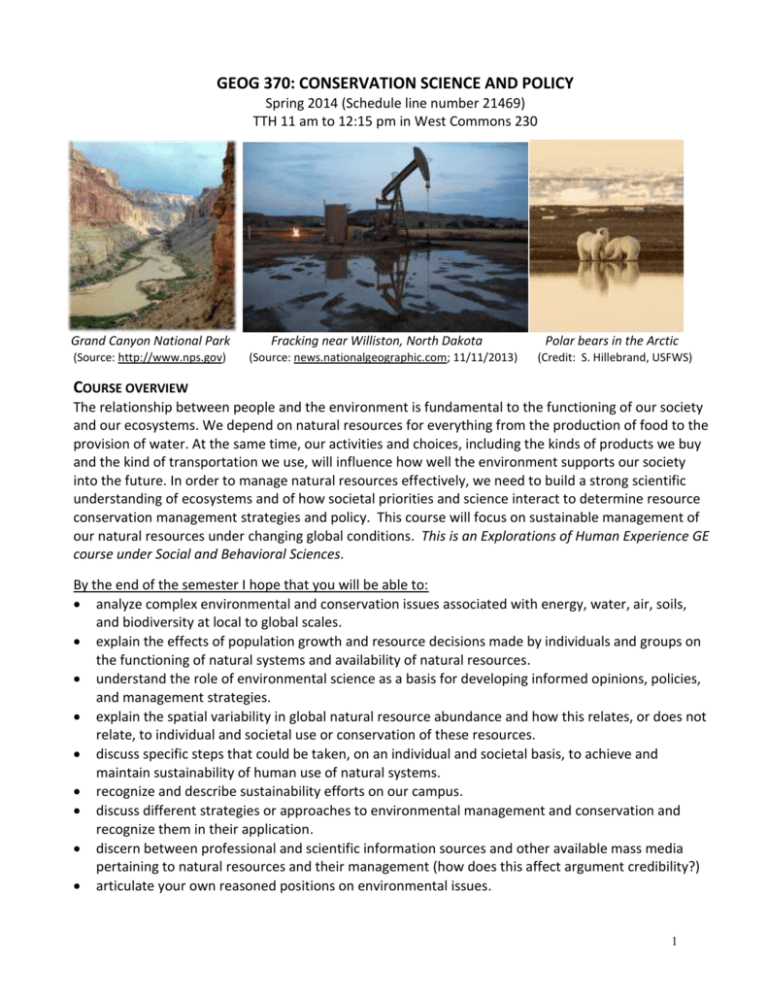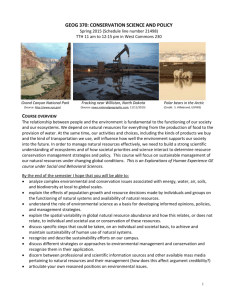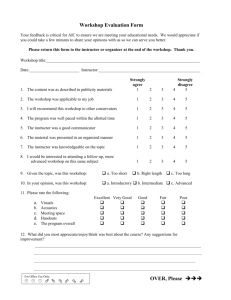View/Open - San Diego State University
advertisement

GEOG 370: CONSERVATION SCIENCE AND POLICY Spring 2014 (Schedule line number 21469) TTH 11 am to 12:15 pm in West Commons 230 Grand Canyon National Park (Source: http://www.nps.gov) Fracking near Williston, North Dakota (Source: news.nationalgeographic.com; 11/11/2013) Polar bears in the Arctic (Credit: S. Hillebrand, USFWS) COURSE OVERVIEW The relationship between people and the environment is fundamental to the functioning of our society and our ecosystems. We depend on natural resources for everything from the production of food to the provision of water. At the same time, our activities and choices, including the kinds of products we buy and the kind of transportation we use, will influence how well the environment supports our society into the future. In order to manage natural resources effectively, we need to build a strong scientific understanding of ecosystems and of how societal priorities and science interact to determine resource conservation management strategies and policy. This course will focus on sustainable management of our natural resources under changing global conditions. This is an Explorations of Human Experience GE course under Social and Behavioral Sciences. By the end of the semester I hope that you will be able to: analyze complex environmental and conservation issues associated with energy, water, air, soils, and biodiversity at local to global scales. explain the effects of population growth and resource decisions made by individuals and groups on the functioning of natural systems and availability of natural resources. understand the role of environmental science as a basis for developing informed opinions, policies, and management strategies. explain the spatial variability in global natural resource abundance and how this relates, or does not relate, to individual and societal use or conservation of these resources. discuss specific steps that could be taken, on an individual and societal basis, to achieve and maintain sustainability of human use of natural systems. recognize and describe sustainability efforts on our campus. discuss different strategies or approaches to environmental management and conservation and recognize them in their application. discern between professional and scientific information sources and other available mass media pertaining to natural resources and their management (how does this affect argument credibility?) articulate your own reasoned positions on environmental issues. 1 INSTRUCTOR INFORMATION Dr. Molly Costello Office location: Storm Hall 311B (3rd floor) Email: mpohl@mail.sdsu.edu Office Phone: 594-8560 Office hours: Tuesdays, 1 pm to 3 pm by appointment. Please let the instructor know in person or by email if you would like to attend office hours. COURSE MATERIALS Textbook Other Withgott, J. and Laposata, M. 2012. Essential Environment: The Science Behind the Stories, 4th edition. San Francisco: Pearson Publ. Other professional readings will be assigned during the semester. Access to the readings via the SDSU library will be provided by the instructor. GRADES AND ASSIGNMENTS Grades will be assigned using a straight scale based on cumulative point totals at end of class: ≥90% = A, 80-89.9% = B, 70-79.9% = C, 60-69.9% = D, <60% = F The points in this course will be distributed as follows: Assessment (60%) Three exams at 20% each (Feb. 18, Mar. 27 and May 6) Assignments, Research Project and Participation (40%) Research paper/project 15% Assignments and exercises 20% Class participation 5% EXAMS (60%) will be comprised of multiple choice and short answer essay questions that test: 1) your knowledge of natural resource science and conservation principles and practices, and 2) your capability in applying this understanding towards specific resource sustainability problems. RESEARCH PROJECT (15%): Each student in this course will have the opportunity to explore a resource conservation issue of their interest. Perhaps you are interested in a local topic such the impact of dams on San Diego beach erosion, or how Tijuana River watershed land use affects ocean pollution. Perhaps you wish to explore how deforestation in Honduras is leading to soil erosion and poverty, or how Beijing industrial growth is affecting air pollution. Maybe you are curious about the impact of climate change on polar bears, or fracking on our national oil and gas reserves and water quality. The final project is an opportunity for you to investigate an issue of your choice, analyze the information you collect, and to provide your evaluation of the best management solution(s) based on environmental science and sustainability, societal needs, and economic and technical feasibility. The paper should be 7-8 pages, typed, double-spaced, 12-point font, normal margins. Primary references should be from professional literature and sources. Include relevant maps, figures and tables as appropriate and cite sources. Papers should be organized following standard APA format (see details and view tutorial at http://www.apastyle.org/) 2 ASSIGNMENTS AND EXERCISES (20%): Homework will be assigned as the class progresses through conservation science and policy topics and appropriate due dates will be posted on Blackboard. HOMEWORK #1: Current Issues in Resource Conservation Over the course of the semester, you will collect three articles from current news (e.g. CNN, NY Times, SD Union-Tribune) that are relevant to resource conservation (e.g. biodiversity and species, agriculture and land use, forests, water use and quality, oceans, energy sources, waste management, climate change). Provide a 2-3 paragraph analysis for each article, using what you have learned in class to explain the problem and potential solutions. What happened? What role did human activities play, if any? Was this event avoidable? Desirable? Is this a sustainable activity? Why or why not? An example of what the final write-up should look like will be available on Blackboard for you to review prior to completing this assignment. The goal is for you to see that: (1) every day around the world resource decisions are shaping our lives and altering ecosystems and (2) you can use the knowledge that you gain in this class to better understand what is happening, why it is happening, and how to make beneficial changes. HOMEWORK #2: SDSU Student Conservation Exploration There are a variety of SDSU organizations that promote conservation, including: Associated Students’ Green Love initiative http://www.as.sdsu.edu/greenlove/ Enviro-Business Society http://www.clube3.org/ Aztec Farms http://www.aztecfarms.org/ Common Experience http://commonexperience.sdsu.edu/ SDSU Global Brigades: Environment and Water groups http://www.globalbrigades.org/empowered/chapter/san-diego-state-university-environmental-brigades-chapter http://www.empowered.org/Water-Brigades-at-San-Diego-State-University For this assignment, you will learn about SDSU conservation group activities and participate in an event (e.g. a Green-bag lunch, Greenfest, team meeting). Details on the assignment and deadlines will be provided early in the semester. HOMEWORK #3: Resource Conservation in San Diego TOUR There will be two tours offered as part of this class: 1) a tour of the San Diego Water Purification Demonstration Project, a project designed to fully recycle water and change public perceptions of “toilet to tap,” and 2) A tour of the Miramar Landfill and Recycling Center, which manages complex issues of waste disposal and recycling in San Diego. You must attend at least one field trip and complete the associated assignment. Details on the assignment and tour dates will be provided early in the semester. HOMEWORK #4: Taking Action to Conserve Resources For this assignment, you will be given a few options that give you the opportunity to become personally involved in resource conservation. For example, you may write a letter to the appropriate government representative regarding an issue of environmental importance to you. Alternatively, you may take personal action (e.g. go “trashless” for two days) and write a report on the experience, its challenges and benefits. Details on this assignment will be provided early in the semester. CLASS PARTICIPATION (5%): There are various components to your participation score, including contributing to class group discussions and completing in-class activities and questions. There are no make-ups for these points. Thus, you must attend class to receive class participation points. 3 TENTATIVE COURSE OUTLINE DATES Jan 23 Jan 28 and 30 Feb 4 and 6 Feb. 11 and 13 Feb. 18 and 20 TOPIC Class Structure and Organization; Intro to Course Science and Sustainability Biodiversity, Species, and Ecology Environmental Economics and Policy Exam 1 on Tuesday, Feb. 18 Research Process and Term Papers (Feb. 20) Feb. 25 and 27 Human Population; Soils, Agriculture and Food Mar. 4 and 6 Biodiversity and Conservation Biology Mar. 11 and 13 Forests and Forest Management Mar. 18 and 20 Fresh Water, Oceans and Coasts Mar. 25 and 27 Water Resources Cont. Exam 2 on Thursday, March 27 Spring Break at SDSU – March 31 to April 4 April 8 and 10 Atmospheric Science and Air Pollution April 15 Global Climate Change Apr. 17 No class: Instructor in Yosemite with different class April 22 and 24 Mining, Energy Sources and Renewable Energy Apr. 29 & May 1 Managing our Waste; Toxicology and Envir. Justice May 6 Exam 3 on Tuesday, May 6 May 8 Sustainable Cities, Sustainable Planet; Course Synthesis Research Projects due May 8 READINGS Chapter 1 Chapters 2 - 4 Chapter 5 Chapters 6 and 7 Chapter 8 Chapter 9 Chapter 12 Chapter 13 Chapter 10 Chapter 14 Chapters 11, 15 & 16 Chapters 10 and 17 Chapter 18 Important note: This syllabus is subject to modification. All changes will be announced in class and on the Blackboard site for this course. You are responsible for being aware of any adjustments. Please contact your instructor if you have any questions about adjustments course timing or content. 4 GENERAL CLASS INFORMATION AND POLICIES 1. Blackboard: This class is supported by Blackboard. Please access Blackboard for your syllabus, assignments, announcements and other class-related items. 2. Late Work: No late assignments are accepted and no make-up exams are given without prior arrangement with the instructor. The grade of any work handed in late, including homework and papers, will be deducted 10% for each day late. Excused late work is granted in only extraordinary circumstances of illness or emergencies. 3. Attendance: Attendance is highly encouraged since 1) a much better understanding of course material arises from attending lecture, and 2) participation points come from in-class discussions and activities. Correspondingly, grades are higher for students with good attendance. 4. Help and Feedback: Office hours are intended to provide individual help, discuss problems or interests, provide comments about the course, or just to get acquainted. I am more than happy to work with you during these times or, if my office hours conflict with your schedule, at other times. Please don’t miss out on getting help because you are reluctant to ask for it. Finally, I would appreciate if you make an appointment to meet with me via email or in person even during office hours so that I can ensure that I am available and not meeting with other students when you arrive. 5. Special Student Circumstances: If you have special circumstances (e.g. disabilities, sports schedule conflicts, foreign language student, or course forgiveness student) please meet with the instructor at the beginning of the course to discuss your situation. 6. Disabilities: If you are a student with a disability and believe you will need accommodations for this class, it is your responsibility to contact Student Disability Services (SDS) at (619) 594-6473. To avoid any delay in the receipt of your accommodations, you should contact Student Disability Services as soon as possible. Please note that accommodations are not retroactive, and that I cannot provide accommodations based upon disability until I have received an accommodation letter from Student Disability Services. Your cooperation is appreciated. The SDS website is http://go.sdsu.edu/student_affairs/sds/ 7. Academic Integrity is one of the fundamental principles of a university community. SDSU expects the highest standards of academic honesty from all students. Violations of academic integrity include the following: (1) unauthorized assistance on an examination, (2) falsification or invention of data, (3) unauthorized collaboration on an academic exercise, (4) plagiarism, (5) misappropriation of research materials, (6) unauthorized access of an instructor’s files or computer account, and (7) any other serious violation of academic integrity as established by the instructor. If your academic integrity is not maintained on a test or assignment, you will automatically receive a grade of zero for that test or assignment and you will be reported to the Center for Student Rights and Responsibilities. Penalties can be severe. For more information on what constitutes plagiarism, please ask me or see this website: http://wps.prenhall.com/hss_understand_plagiarism_1/0,6622,427064-,00.html 5









